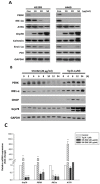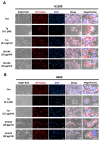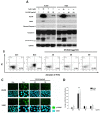Ethyl Acetate Extract of Scindapsus cf. hederaceus Exerts the Inhibitory Bioactivity on Human Non-Small Cell Lung Cancer Cells through Modulating ER Stress
- PMID: 29933620
- PMCID: PMC6073426
- DOI: 10.3390/ijms19071832
Ethyl Acetate Extract of Scindapsus cf. hederaceus Exerts the Inhibitory Bioactivity on Human Non-Small Cell Lung Cancer Cells through Modulating ER Stress
Abstract
Unfolded protein response (UPR) is a cytoprotective mechanism that alleviates the protein-folding burden in eukaryotic organisms. Moderate activation of UPR is required for maintaining endoplasmic reticulum (ER) homeostasis and profoundly contributes to tumorigenesis. Defects in UPR signaling are implicated in the attenuation of various malignant phenotypes including cell proliferation, migration, and invasion, as well as angiogenesis. This suggests UPR as a promising target in cancer therapy. The pharmacological effects of the plant Scindapsus cf. hederaceus on human cancer cell lines is not understood. In this study, we identified an ethyl acetate extract from Scindapsus cf. hederaceus (SH-EAE), which markedly altered the protein expression of UPR-related genes in human non-small cell lung cancer (NSCLC) cells. Treatment with the SH-EAE led to the dose-dependent suppression of colony forming ability of both H1299 and H460 cells, but not markedly in normal bronchial epithelial BEAS-2B cells. SH-EAE treatment also attenuated the migration and invasion ability of H1299 and H460 cells. Moreover, SH-EAE strikingly suppressed the protein expression of two ER stress sensors, including inositol requiring enzyme-1α (IRE-1α) and protein kinase R-like ER kinase (PERK), and antagonized the induction of C/EBP homologous protein (CHOP) expression by thapsigargin, an ER stress inducer. SH-EAE induced the formation of massive vacuoles which are probably derived from ER. Importantly, SH-EAE impaired the formation of intersegmental vessels (ISV) in zebrafish larvae, an index of angiogenesis, but had no apparent effect on the rate of larval development. Together, our findings demonstrate, for the first time, that the ability of SH-EAE specifically targets the two sensors of UPR, with significant anti-proliferation and anti-migration activities as a crude extract in human NSCLC cells. Our finding also indicates potential applications of SH-EAE in preventing UPR activation in response to Tg-induced ER stress. We suggest that SH-EAE attenuates UPR adaptive pathways for rendering the NSCLC cells intolerant to ER stress.
Keywords: ER stress; NSCLC; Scindapsus cf. hederaceus; UPR; ethyl acetate extract; non-small cell lung cancer cell; selective anti-cancer therapeutics; unfolded protein response.
Conflict of interest statement
The authors declare no conflicts of interest.
Figures













References
MeSH terms
Substances
LinkOut - more resources
Full Text Sources
Other Literature Sources
Molecular Biology Databases
Research Materials
Miscellaneous

